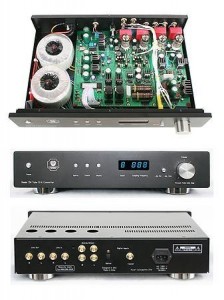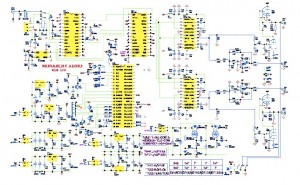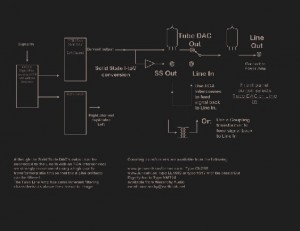The January issue contained a review of the Monarchy Audio M24, which is essentially a DAC and an active line-stage that is built on a single chassis. After a couple of months of listening to the M24, I concluded that that this piece offered audio enthusiasts a true taste of high-end audio reproduction. The M24 is not inexpensive by any stretch of the imagination, however it’s design allows the cost conscious audio enthusiast to replace two components, and associated cabling with one unit which is capable of holding it’s own with other comparably priced audio components. After the review of the M24 was completed I contacted Monarchy Audio in order to make shipping arrangements to return this piece. During this conversation Mr. Poon informed me that a successor to the M24 has just become available; and would I be interested in listening to it? Since I enjoyed my time with the M24 quite immensely, I was more than interested in hearing an updated version. Within a week the UPS driver dropped off a package from Monarchy Audio, which contained the NM24 DAC/Line stage.
Quite often audiophiles talk about “system synergy”, which is a fancy term that is intended to describe how a set of components works together. Since every component has its own particular electrical characteristics, and a sonic signature that is unique unto itself, it is possible to pair up electronics that do not sound good together. Of course this works both ways, and it is possible to find a combination of components that sound heavenly, and cost far less than one would expect. This kind of system synergy is what audio dreams are made of. The key to creating a good system is to find a component that is flexible, which means that its output can be manipulated to properly match it to other components in the system. This type of component has a significant value to the real world audio enthusiast. Components with a high degree of flexibility will work in a wide array of system configurations, and can be kept for a long time period due to their chameleon like nature. Monarchy has designed a high level of flexibility into the NM24, which makes it even a greater value to audio enthusiasts who have real world budgets.
Monarchy NM24 review
The output stage of the DAC portion of the NM24 is where Mr. Poon has added a crafty little twist. The NM24 is now a hybrid DAC, with the ability to employ a traditional solid-state configured output stage, or an active tube output configuration. There are two sets of output jacks on the back of the unit. One set of RCA jacks is labeled solidstate DAC output, while the other is Tube DAC output. Monarchy has designed two separate output stages for the DAC in the NM24, and both of these operate independent of each other. I should emphasize that the signal that feeds the tube output stage of the NM24 comes directly off the digital to analog converter chip, and does not pass through the op-amp that is employed in the solid-state output circuit. The owner of a NM24 now has the ability to choose between two different DAC configurations, both of which give a different presentation to the music. To put it quite simply, Monarchy has found a way to offer a highend digital analog converter that can be configured for either solid-state or vacuum tube output.
Monarchy has also upgraded the D to A converter chip in the NM24 to the Burr Brown PCM 1704. The previous generation machine was built around the Burr Brown PCM 63, which has been taken out of production. The PCM 1704 has a reputation as a high quality chip set, but Mr. Poon decided go whole hog, and has installed the Select grade of this chip. Burr Brown performs a series of tests on a production run of PCM 1704s, and those chips that are the cream of the crop are given the Select designation. This Burr Brown chips allows for true 24-bit word length, so the NM24 is capable of authentic 24/96 performance. Even though the PCM 1704 gives this DAC the ability to play a high-resolution format, the real value of it can be heard when playing a conventional Redbook format disc. This chip set is capable of preserving the purity of the data stream, which is responsible for the NM24s ability to reproduce the subtle nuances of a performance. The PCM 10704 Select chip set is the heart and soul of this player. If you do a bit of research you will find that this chip set has been used in machines from Wadia and Boulder, which have been considered to be some of the finest digital pieces ever produced.
Other than these two changes, the NM24 circuit is essentially the same as the M24 D to A converter. Mr. Poon installed a few minor refinements to the unit, such as larger toroidal transformers, and an upgrade of a few capacitors in the unit, but these are essentially refinements of a proven design. The circuit layout of the pre-amplifier is carried over from the previous generation. The chassis of the NM24 retains the conservative appearance that all Monarchy components have, although the finish is now all black, and the silver faceplate that characterized the M 24 is no longer available. Monarchy Audio has a long history of building high quality digital components, and the NM24 is the end result of many years of designing, building, testing, and critically listening to the end result. It is no surprise then, that this unit is similar in many ways to its predecessor. Although this batch of improvements that Monarchy has implemented results in a component that can be used successfully in a wide variety of systems.
I decided use the NM24 with a couple of other Monarchy Audio pieces that I have on hand. The Electra-Print 300DRD amplifiers came out of my system, and were replaced with a single Monarchy SM 70 PRO amplifier. The Audio Nirvana Super 12 speaker system is extremely efficient, and matches quite well with the 35-wpc Monarchy amplifier. The JVC XL-Z1050TN filled the role of digital transport. I ran both the NM24 and the JVC into a Monarchy Audio AC Regenerator. This power conditioner does an admirable job of providing clean power to the digital components. Audio Magic Illusions 4D speaker wire, interconnects, and digital cable were used throughout the system. Finally, Every component that had an IEC connector was fitted with power cords from the Audio Magic Extreme line of wire.
Since the NM24 can be used in several different configurations, it does not allow for a straightforward review process. I have decided to divide this review into two sections. The first half of the review will concentrate on the digital to analog converter side of the NM24. During these listening sessions I left the Electra-Print PVA pre-amplifier in my system, and am able to evaluate the solid state and tube output stages of the NM24. In the second half of the review, I removed the PVA, and ran both DAC configurations through the line-stage contained in the unit. In order to isolate the sonic characteristics of each configuration of this piece, I chose to use a single song instead of multiple tracks from different artists. “Just Squeeze Me (But Don’t Tease Me” performed by Dave Grusin [Homage to Duke; GRP Records GRD 9715] is a versatile piece with a lively bass line, captivating horn solos, and a classic vocal solo by Terry Clark. The differences between the various configurations of the NM24 are easily heard on this song, and I immensely enjoyed listening to the changes in the presentation of the music that can be had with the Monarchy piece.
The solid-state output of the NM24 has the strengths of a traditional multi-bit digital to analog converter. By feeding the solid-state output signal into a passive pre-amp, I was able to achieve the highest level of resolution in my system. The acoustic bass had excellent definition and extension. However, the texture is a bit dry, and at times it could stand to be fleshed out. The horns in general, especially the saxophones were presented with plenty of detail, and had a natural sounding presentation. The vocal segments from Terry Clark came through clearly, which is quite an accomplishment. Clarke’s vocals were rich and full sounding, yet had a precise edge to each phrase, While each vocal section degenerated into his signature mumble, the NM24 was capable of presenting his performance with excellent resolution. The major drawback to the pairing of the passive pre-amp and solid-state output is a compression of the overall size of the soundstage. Of all of the possible combinations I listened to in this review, this one resulted in the smallest image size. It appears to me that this is due to the use of a passive pre-amp. I believe that the solid-state side of the NM24 will benefit from being paired with an active pre-amplifier.
As good as the solid-state outputs of the NM24 are, I still prefer listening to this DAC through the tube output stage. While some of the fine detail of the music can be obscured in this configuration, there are significant improvements in other areas. First of all the soundstage grew taller, and extended farther into my listening room. Instruments no longer sounded two dimensional, but instead were firmly planted in the soundstage. The music also took an easy flow, with a feel that sounded closer to real music than the solid-state output stage was capable of. The horn portions of this track sounded exquisite, and were a joy to listen to. I directly attribute my evening long listening sessions to the smooth and graceful presentation of the tube output stage of this DAC. I could not discern any issues with the pairing of the Electra Print PVA pre-amplifier and the tube output stage of the NM24. In my experience, this is a superior combination than the previous solid-state pairing that I listened to. While this combination produced excellent results, in the end it was still not the best sound that I was able to hear from the NM24.
When I reviewed the M24, I was quite satisfied with the performance of the unit as a combination line-stage and DAC. At the end of my listening sessions, for the most part I still preferred this configuration. The positive attributes of the tube output DAC were magnified when used in conjunction with the tube line-stage of the NM24. When both tube stages are used, the NM24 is capable of creating the illusion of a musical performance. The soundstage becomes even larger, and the instruments stand out in sharp contrast from the recording venue. There is a touch of warmth added to the midrange area, which highlighted the vocal portions of the track. While this presentation is noticeably different than the solid-state configuration, it is easy to be come accustomed to it. During one listening session, I removed the Phillips 6DJ8 tubes, and substituted replaced them with a set of Edicron 7DJ8’s. Quite simply, the Edicron is the superior tube in this application. The NM24 lost the euphonic warmth that I attribute to the stock tube, and the NM24 ability to resolve finer details improved quite significantly. I feel that in most applications, the owners of the NM24 will obtain the best results by using the tube DAC output stage along with the active tube line-stage.
It is possible to bypass the tube stage of the DAC in the NM24, yet still utilize the tube line-stage. This requires installing a set of interconnects between the solid-state output jacks, and the input jacks on the line-stage. Mr. Poon also recommends passing the signal through a pair of nickel core transformers. . Since my Electra-Print PVA pre-amplifier contains a set of transformers, it was quite simple for me to install them. I placed a quick phone call to Jack Elliano in order to verify that these transformers would work in this application. Jack assured me there would be no issues, as long as I set the volume pot on the PVA at 8 o’clock.1. If I had a pair of transformers that were custom wound for this application, I could have just installed them in line. When I hit play on JVC, it was readily apparent that Monarchy Audio was on to something with this arrangement. The sound retained cohesive presentation of the all tube mode, yet there was a noticeable increase in detail and the perceived speed of the music. When used in conjunction with the Electra-Print transformers, the solid-state outputs stage performed at the same overall level as the tube output stage. I am not saying that the sound was identical, but instead presented a different shade to the music that is not available in the all tube configuration. It is easy to see how a system could benefit from this arrangement of the NM24.
The Monarchy NM24 is clearly a worthy successor to the M24. Mr. Poon has applied innovate solutions to everyday audio issues. The unit uses a tried and true circuit design and high quality parts. There are a few state-of the-art components in the NM24, such as the D to A converter chip set. In reality, the NM24 owes its high-end performance to the gradual refinement of a welldesigned audio circuit. Monarchy has many years of experience in developing innovative digital gear, and the lessons they have learned have been applied to this piece. Audio enthusiasts who have limited budgets need to be aware of the abilities of the NM24. This unit is a high-end DAC and a fine tube pre-amp. To the best of my knowledge, this component is unique in the audio world due to its multiple configuration design. . Even though the NM24 is resides at a price point that is considered mid-tier, in reality it is a high-end piece of electronics. Combine the NM24 with a high quality amplifier such as the SM 70 PRO, and you can create a system that will run circles around some very expensive gear. If you get a chance to audition a NM24, you really should do so, and don’t be surprised if it stays in your system.
The Electra-Print transformer required for this application is the PVA-2n. This transformer sells for $59 each, and two are required. It is a simple matter of installing RCA plugs on the input and output wires, and then plugging it into the appropriate jacks on the back of the NM24.
external link: Monarchy NM24 website
 from affordableaudio, By John Hoffman
from affordableaudio, By John Hoffman




I own a pair of Sophia electric m88 tube monoblocksn at 50w they are kt88 tubes, what are your suggestions on this set up, I work of rthe u.s. navy and not a rich man, I wish hahahah, anyway is it dual voltage for travel overseas and would I need shielded or unshielded cables.
thank you for your time
Thomas O’Toole
I’m curious what is happening with Monarchy Audio…when I click the Monarchy Audio link from the search result – there is something about a federal action about Ugg boots.
Is Monarchy still producing and selling their NM24 DAc – I am very interested since reading your review.
I thought maybe You have better communication with them